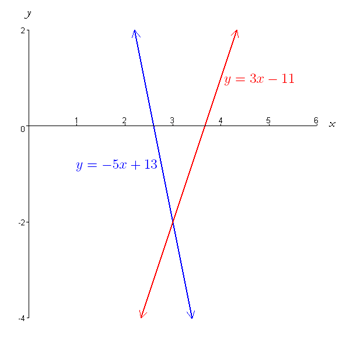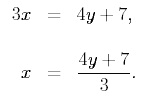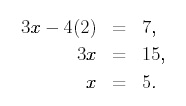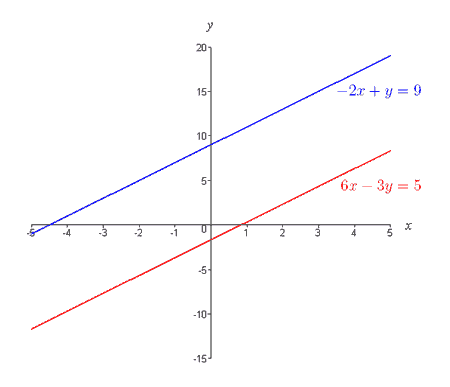Linear Functions
Solving Linear Equations
| There will be many instances in your study of biology where you will have to solve an equation. Here, we discuss solving linear equations beginning with a linear equation in one variable, and then solving a system
of two linear equations by two different methods.
A Simple Example: A Linear Equation in One Variable Solving linear equations in one variable is straightforward, as illustrated by the following example. Suppose we are asked to solve the following equation, 3(4x − 1) = 6(2 − 8x). First, we recognize that this is an equation in one variable, x. To solve such an equation means to find the value of x such that the above equation holds true. To do this, we isolate x by distributing and combining like terms,
Therefore, we find that x = 1/4 solves the above equation. Solving a System of Two Linear Equations Solving a system of two linear equations is the equivalent of finding the point (x, y) where the two lines intersect. We will describe two different methods used to solve a system of two linear equations: substitution and elimination.
The Method of Substitution The method of substitution is often a fast way to solve two linear equations. As stated above, solving two linear equations is equivalent to finding the point at which the two lines intersect. Consider the following two lines given by the equation, y = 3x − 11 5x + y = 13. Can you determine the point in the xy-plane at which these two lines intersect without drawing a graph? To determine the point of intersection by substitution, we solve one of the equations for either x or y and substitute this into the other equation. In our case, equation 1 is already solved for y. Substituting this value of y into equation 2 gives, 5x + y = 5x + (3x − 11) = 13. Notice that we have reduced the two equations in two variables to a single equation in one variable. We now solve the above equation for x by combining like terms,
Thus, we find the x-coordinate of the point of intersection to be x = 3. To find the corresponding y-coordinate of the point of intersection, we substitute the x-coordinate that we just found into either linear equation as follows, y = 3 · 3 − 11 = 9 − 11 = −2. Using the other linear equation, we find agreement, y = −5 · 3 + 13 = −15 + 13 = −2. Therefore, the lines y = 3x − 11 and y = −5x + 13 intersect at the point (3, -2).
Substitution is a convenient method to solve systems of equations when one of the two equations has a coefficient of 1 on either x or y. If no variable has a coefficient of 1, substitution becomes a bit more cumbersome. Consider the following example, 3x − 4y = 7, −2x + 5y = 0. Since neither equation has a coefficient of 1 on x or y, we would have to solve for x or y in order to make a substitution. For example, we could solve for x in the first equation as,
This is an awkward looking expression for x that we would have to substitute into equation 2 as,
While we could go on to solve for y, you can see that substitution has produced a messier expression, and it is easy to make an error with such an expression. We will now look at a simpler way to solve such equations.
We will now learn to solve the previous system of two linear equations by elimination, 3x - 4y = 7, -2x + 5y = 0. The overall idea behind elimination is to multiply both sides of each equation by a constant that will allow one of the variables (either x or y) to be eliminated when the two equations are either added or subtracted. In this example, we will eliminate the variable x. The coefficient of x is 3 in equation 1 and 2 in equation 2. Therefore, if we wish to eliminate the variable x, we need to make the coefficients of x equal to one another and subtract the equations or opposite of one another and add the equations. The easiest ways to do this is to multiply both sides of the first equation by 2 and both sides of the second equation by 3 as, 2 (3x − 4y) = 2 (7) , 3 ( −2x + 5y) = 3 (0) , which gives, 6x − 8y = 14, −6x + 15y = 0. Now the coefficient of x in equation 1is 6, and the coefficient of x in equation 2 is -6. By adding the two equations together, we can eliminate x altogether as shown, −8y + 15y = 14 + 0. Therefore, we find that 7y = 14 y = 2. Now we need to find the x-coordinate of the point of intersection. We can do this by substituting the value of y, in this case y = 2, into either linear equation as follows,
Using the other linear equation we arrive at the same result, Thus, we find the solution to this system of linear equations to be (x, y) = (5, 2). To demonstrate elimination with another example, consider the following system of equations, 3x + 6y = 1, 8x − 12y = 9. To eliminate the variable x, you could multiply both sides of the first equation by 8 and both sides of the second by 3 as, 24x + 48y = 8, 24x − 36y = 27. To finish eliminating x, you could subtract equation 2 from equation 1 as, Alternatively, you could eliminate the variable y by multiplying both sides of the first equation by 2 as, 6x + 12y = 2, 8x − 12y = 9. To finish eliminating y, you could add equation 1 to equation 2 as,
How many solutions should I expect? A system of two linear equations may have one solution, no solution, or infinitely many solutions. We have just seen three examples of linear systems that have one solution. An example of a system that has no solution is as follows, 6x − 3y = 5, −2x + y = 9. If we attempt to find a solution, we multiply equation 2 by 3 to get, −6x + 3y = 27. Adding this equation to equation 1 we get, 0 = 32. This statement is clearly not true. Thus, this system of linear equations has no solution. If you were to graph these two equations, you would see that the two lines that represent these equations are parallel to one another. Parallel lines with distinct y-intercepts will never intersect thereby providing no solution.
An example of two linear equations that have an infinite number of solutions is as follows, −3x + 12y = 15, −x + 4y = 5. If multiply equation 2 by 3 we get, −3x + 12y = 15. As you can see, multiplying by 3 transformed equation 2 into equation 1, and subtracting the two equations gives, 0 = 0. The statement 0 = 0 is always true (i.e. for all values of x and y), and we say that this system has an infinite number of solutions. There are an infinite number of solutions because the two lines are the same and lie on top of one another. Thus, all points lying on these lines solve these two linear equations simultaneously. Because there are an infinite number of points on a line, there are also an infinite number of solutions to these equations. ***** In the next section we will discuss how to use linear equations to model biological data. |
The Biology Project > Biomath > Linear Functions > Solving Linear Equations
The Biology Project
Department
of Biochemistry and Molecular Biophysics
The University of Arizona
January 2006
Contact the Development Team
http://www.biology.arizona.edu
All contents copyright © 2006. All rights reserved.


 You can verify this point graphically as seen below,
You can verify this point graphically as seen below, 

![equation: -2[(4y+7)/3] + 5y = 0](images/solvlineqn5.gif)





